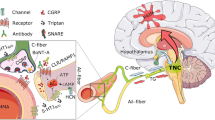Abstract
This study demonstrates that low voltage-activated (LVA) Ca2+ channels and at least five pharmacologically distinct high voltage-activated (HVA) Ca2+ channels exist in most rat CNS neurons, with the exception of cerebellar Purkinje cells. These LVA and HVA Ca2+ channels (including their subtypes) are differentially distributed among various CNS regions. The pharmacological diversity of these channels and their heterogeneous distribution on the nerve cell somata and nerve endings appear relevant in the development of new and region-specific pharmacological agents for clinical use.
Similar content being viewed by others
References
H. Ishibashi, J. S. Rhee, and N. Akaike, “Regional difference of high voltage-activated Ca2+ channels in rat CNS neurons,”NeuroReport,6, 1621–1624 (1995).
T. P. Snutch, J. P. Leonard, M. M. Gilbert, et al., “Rat brain expresses a heterogeneous family of calcium channels,”Proc. Natl. Acad. Sci. USA,87, 3391–3395 (1990).
K. Takahashi, M. Wakamori, and N. Akaike, “HippocampalCA1 pyramidal cells of rats have four voltage-dependent calcium conductances,”Neurosci. Lett.,104, 229–234 (1989).
N. Akaike and N. Harata, “Nystatin perforated patch recording and its applications to analyses of intracellular mechanisms,”Jpn. J. Physiol.,44, 433–473 (1994).
F. A. Edwards, A. Konnerth, B. Sakmann, and T. Takahashi, “A thin slice preparation for patch clamp recordings from neurones of the mammalian central nervous system,”Pflügers Arch,414, 600–612 (1989).
I. Llano, A. Marty, C. M. Armstrong, and A. Konnerth, “Synaptic- and agonist-induced excitatory currents of Purkinje cells in rat cerebellar slices,”J. Physiol.,434, 183–213 (1991).
T. Nakagawa, T. Shirasaki, M. Wakamori, et al., “Excitatory amino acid response in isolated nucleus tractus solitarii neurons of the rat,”Neurosci. Res.,8, 114–123 (1990).
N. Akaike, P. G. Kostyuk, and Y. V. Osipchuk, “Dihydropyridine-sensitive low-threshold calcium channels in isolated rat hypothalamic neurones,”J. Physiol,412, 181–195 (1989).
A. Khateb, P. Fort, M. Serafin, et al., “Rhythmical bursts induced by NMDA in guinea-pig cholinergic nucleus basalis neuronsin vitro,”J. Physiol.,487, 623–638 (1995).
J. J. Hablitz and D. Johnston, “Endogeneous nature of spontaneous bursting in hippocampal pyramidal neurons,”Cell Mol. Neurobiol,1, 325–334 (1981).
I. M. Mintz, M. E. Adams, and B. P. Bean, “P-type calcium channels in rat central and peripheral neurons,”Neuron,9, 85–95 (1992).
D. R. Hillyard, V. D. Monje, I. M. Mintz, et al., “A new conus peptide ligand for mammalian presynaptic Ca2+ channels,”Neuron,9, 69–77 (1992).
R. Llinas, M. Sugimori, D. E. Hillman, and B. Cherksey, “Distribution and functional significance of the P-type voltagedependent Ca2+ channels in the mammalian central nervous system,”Trends Neurosci.,15, 351–355 (1992).
G. Vardi, Y. Mori, G. Mikala, and A. Schwarz, “Molecular determinants of Ca2+ channels function and drug action,”Trends Pharmacol. Sci.,16, 43–49 (1995).
J. F. Zhang, A. D. Randall, P. T. Ellinor, et al., “Distinctive pharmacology and kinetics of cloned neuronal Ca2+ channels and their possible counterparts in mammalian CNS neurons,”Neuropharmacology,32, 1075–1088 (1993).
N. Akaike, J. S. Rhee, Y. H. Jin, and K. Ono, “GABA: receptor. transporters and metabolism,” in:Ontogenic Changes of GABA A Function of the Rat Meynert Neuron, C. Tanaka and N. G. Bowery (eds.), Birkhauser Verlag, Basel (1996), pp. 201–207.
D. Murchison and W. H. Griffith, “Low-voltage activated calcium currents increase in basal forebrain neurons from aged rats,”J. Neurophysiol.,74, 876–887 (1995).
D. W. Choi, “Calcium-mediated neurotoxicity: Relationship to specific channel types and role in ischemic damage,”Trends Neurosci.,11, 465–469 (1988).
A. B. MacDermott, M. L. Mayer, G. L. Westbrook, et al., “NMDA-receptor activation increases cytoplasmic calcium concentration in cultured spinal cord neurones,”Nature,321, 519–522 (1986).
K. Takahashi and N. Akaike, “Calcium antagonist effects on low-threshold (T-type) calcium current in rat isolated hippocampalCA1 pyramidal neurons,”J. Pharmacol. Exp. Ther.,256, 169–175 (1991).
B. J. Alps, C. Calder, and A. D. Wilson, “Comparative protective effects of nicardipine, flunarizine, lidoflazine and nimodipine against ischemic injury in the hippocampus of the Mongolian gerbil,”Br. J. Pharmacol.,93, 877–883 (1988).
T. Beck, J. Nuglish, D. Sauer, et al., “Effects of flunarizine on post-ischemic blood flow, energy metabolism and neuronal damage in the rat brain,”Eur. J. Pharmacol.,158, 271–274 (1988).
J. P. Cullen, J. A. Aldrete, L. Jankovsky, and F. Romo-Solas, “Protective action of phenytoin in cerebral ischemia,”Anesth. Analg.,58, 165–169 (1979).
Y. Yaari, B. Hamon, and H. D. Lux, “Development of two types of calcium channels in cultured mammalian hippocampal neurons,”Science,235, 680–682 (1987).
C. A. Endersby, E. G. Brown, and M. S. Perelman, “Safety properties of lacidipine: A review of clinical data,”J. Cardiovascul. Pharmacol.,17, Suppl. 4, S45–47 (1991).
A. Scriabine, T. Schuurman, and J. Traber, “Pharmacological basis for the use of nimodipine in central nervous system disorders,”FASEB J.,3, 1799–1806 (1989).
S. Kawamura, N. Yasui, M. Shirasawa, and H. Fukasawa, “Effects of a Ca2+ entry blocker (nilvadipine) on acute focal cerebral ischemia in rats,”Exp. Brain Res.,83, 434–438 (1991).
A. Shiino, M. Matusda, T. Susumu, and J. Handa, “Effects of the calcium antagonist nilvadipine on focal cerebral ischemia in spontaneously hypertensive rats,”Surg. Neural.,35, 105–110 (1991).
Author information
Authors and Affiliations
Rights and permissions
About this article
Cite this article
Akaike, N. Distribution of different types of calcium channels in the brain structures. Neurophysiology 29, 233–240 (1997). https://doi.org/10.1007/BF02461234
Received:
Issue Date:
DOI: https://doi.org/10.1007/BF02461234




